In an ever more vanilla world, we‘ve always had DAF, doing its thing, its own way. The XF 530 Euro 6 Super Space Cab is the latest dashing Dutchman, and we took a look at the first two here, hoping the DAF flame of independence still burns strong.
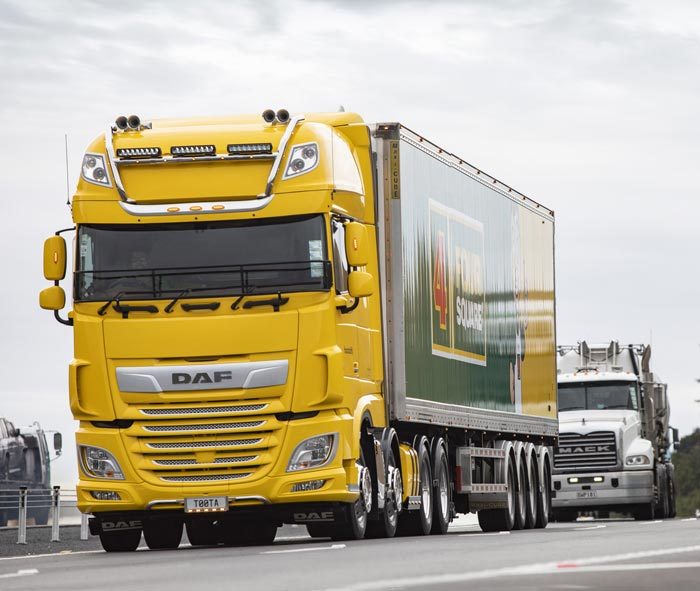
This month‘s road test starts unlike any we‘ve ever written before. It starts with a man sitting on a table. Odd as that may seem, it‘s a metaphor for so much when you‘re talking about the DAF product. The man in question was general sales manager for Southpac Richard Smart, and the table was the utility table that pulls out of the central dash console in the new XF 530 Euro 6. “You can see how well they‘re built,” he said as he pulled the table out, sat on it, and tucked his legs up. Fair to say Richard‘s not the biggest unit at 85kg, and as he said, you probably wouldn‘t want to push things much further, but this was still a fully-grown man sitting on a pullout table in a truck. If you‘ve read my DAF writings in the past, you‘ll know I had a positive bonding experience driving an XF105.510 for a month some years back that‘s always engendered a sense of enthusiasm when it comes to investigating the product further.
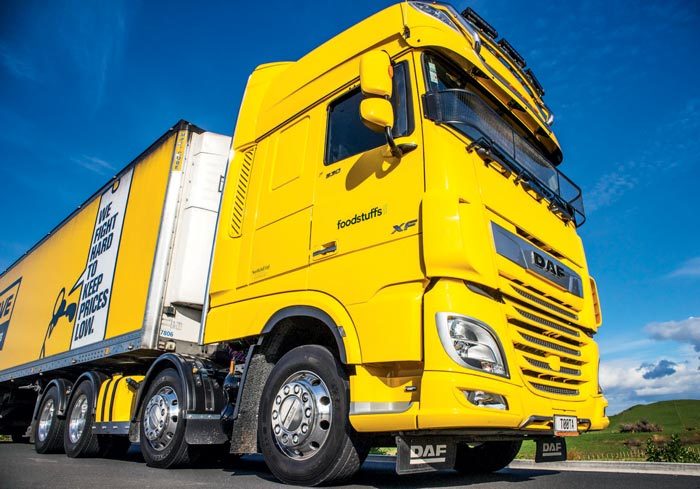
I‘ve also made mention of my observation that the folks at DAF are their own people and have always done their own thing – they don‘t necessarily hare off after the herd. That line of thought originates in the writing of European journos in the 80s and early 90s, Pat Kennett and co, in mastheads like TRUCK magazine. DAF‘s individuality has also played a huge part in the brand securing a foothold in Aotearoa (see sidebar). As with all of us, much has changed in DAF‘s world over the past quarter of a century, but there‘s still an underlying individuality that ‘fingerprints‘ DAF‘s latest Euro 6 range as most definitely DAF. They don‘t have to be big: the location of the control wheel for the central diagnostics screen on the dash, a proper table, an engine that‘s happy being just over half a thousand horsepower. Small things yes, but these days, even if you‘re half a step from the madding crowd, you‘ll stand out.
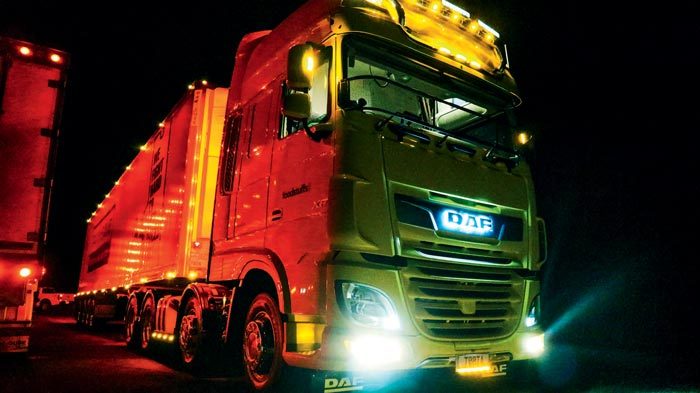
Photo: Looking magnificent in Mokau.
Still hip, less square, loved by many
The previous XF105 was certainly a softening of the stark ‘squareness‘ that was the original XF95, and the XF 530 Euro 6 is even a bigger jump into a more alluring and curvaceous aesthetic. There are few who would argue the 530 isn‘t a pretty truck. The new grille takes a couple of minutes to adjust to: some might say the grille and the DAF badge pull the front down a tad too much, that‘s probably more a CF thing than an XF. The XF seems well balanced in terms of appeal to man‘s primal visual triggers. You see it, you like it, you want to drive it. Descriptively you could go on forever about the visual cues, suffice to say it‘s a whole new animal: grille, flanks, guards, quarters, and glass. Softer looking, slipperier through the air, but still easily identifiable as a DAF. Launched at the Birmingham Show in 2017, ours is the latest and third evolution of the company‘s Euro 6 platform that first appeared in Europe in 2013. Like some other OEMs, props to Southpac for getting them here before any local mandating of Euro 6. It‘s environmentally responsible and shows a genuine interest in their customers‘ bottom line, for the one thing operators are quickly learning about Euro 6 is it‘s rewriting the book on fuel consumption, not just clean air. The DAF is no different, with new EAS (Exhaust Aftertreatment System), power and drivetrain improvements, a new climate control system, aerodynamics and electronic architecture all contributing to a potential 7% consumption improvement according to the company.
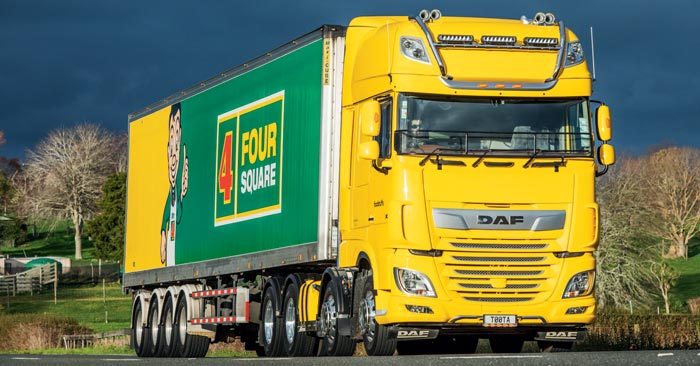
Oh, if you‘re wondering why Birmingham was chosen as the V3 Euro 6‘s launch site, it‘s all about recognition of popularity. DAF in the UK is king! Tapping into our IToY connections, in the equal to or over 16 tonne market share, DAF secures a staggering 29.4% of the UK market. The only place they‘re higher is of course The Netherlands at 31.8%, and the average across the EU-plus-three (England, Ireland, Wales) is 16.2%. Talking sales beyond the EU, in 2018 DAF sold one in every five trucks abroad to 77 different countries – outside Europe – a total of 9200 vehicles. So, DAF is big! Here in New Zealand, there have been Euro 6 evaluation units on the ground since February 2019, sorting out specification fineries and things like optimal gearing and AMT tuning. While that was going on, five master service technicians were trained, dealer service training was sorted with the help of two training engines sourced specifically for that purpose, some flash-as diagnostic laptops were bought, and a $1.1 million parts stock amassed. The real masterstroke though was the trainers‘ partnership with TR Master Drive. Twenty-two trainers across 16 locations will facilitate a free 6- to 8-hour in-cab education for two drivers for every new Euro 6 sold, after which the drivers will receive an NZTA qualification. So, by the time New Zealand‘s national Road Show for the truck‘s launch set sail from Southpac‘s Wiri HQ in February this year, all the ducks were well and truly lined up … and then we all went batty.
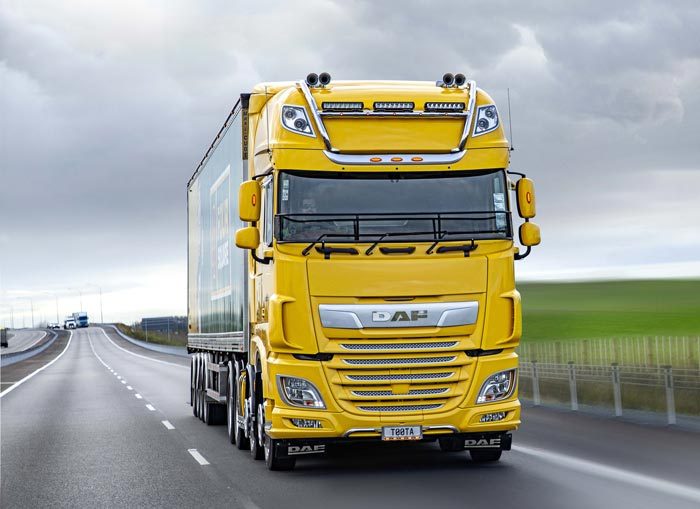
Photo: The DAF looks equally at home in the Ngahinapouri country side (top) or on the Waikato expressway.
Now, where were we?
When we talked to Richard at Wiri in early June, the good news was enquiry was high and the order book strong. We were there for a sneaky peek at a truck that was one of a pair we were itching to get our hands on. Graham and Michelle Redington have purchased the first two XF 530 Euro 6 Super Space Cabs for a contract they have with Foodstuffs Ltd, serviced under their Northchill Ltd brand. One is a 6×4 tractor, and the other an 8×4, which incidently also holds the title of being the first XF 530 Euro 6 8×4 highway tractor with a Super Space Cab in the world. When the Redingtons asked if we‘d be interested in featuring them, it was hard to contain our hysteria.
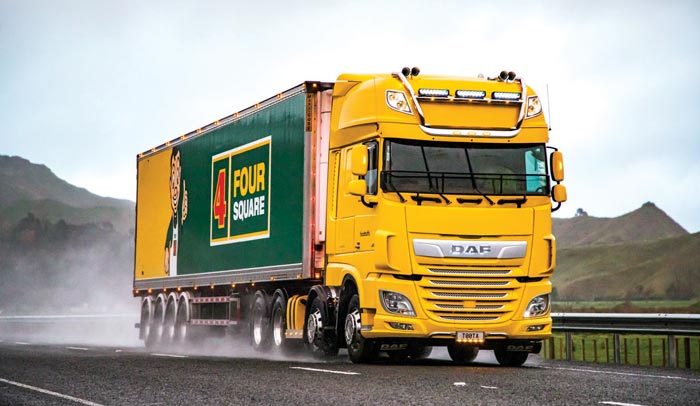
Photo: The DAF kicks up some spray, heading north at the entrance to the Awakino Gorge.
Jekyll and Hyde highway
We met driver Kaine Wood in Otorohanga for the first of two nights in the 8×4 with a MaxiCUBE quad reefer on-hook, doing Auckland – Mokau swaps. “Yeah, it‘s a nice machine, easy place to spend a day,” said Kaine as the big Dutchman loafed away from the town, effortlessly collecting kilometres-per-hour without the occupants really being aware. Loaded with mixed grocery, Kaine said we were about 38 tonne all up, giving us a wonderful 10.3kW/tonne (13.8hp). Imagine an RFL driver of say 1971 having 13.8hp to the tonne? “It‘s typical grocery,” said Kaine. “There‘s one leg where we have to keep an eye on weight, most of the rest of the time it‘s room that‘s the issue more than weight.” Beyond the town limits and up to speed, we thought back to the test we did in an identically set up XF105 owned by Will Gundesen (New Zealand Trucking magazine July 2018). It was immediately apparent the Euro 6 seemed a markedly different beast in terms of ride and feel. The fourpoint mechanical and shock absorber cab suspension felt livelier, maybe softer, and the influence of the second steer on the ride seemed more apparent. The conundrum in it all was the roads. I have no doubt whatsoever that in the two years since we rode in the 105, the regional state highway network has devolved further toward an aluminium-barriered highway to hell. Maybe it wasn‘t the new truck‘s dynamics, maybe it‘s the playing surface that caused a slight second steer kick and bit of bobbling. Lateral stability too didn‘t appear quite as firm, although it was no issue, and remember, there‘s a lot of cab north of the door‘s top sill.
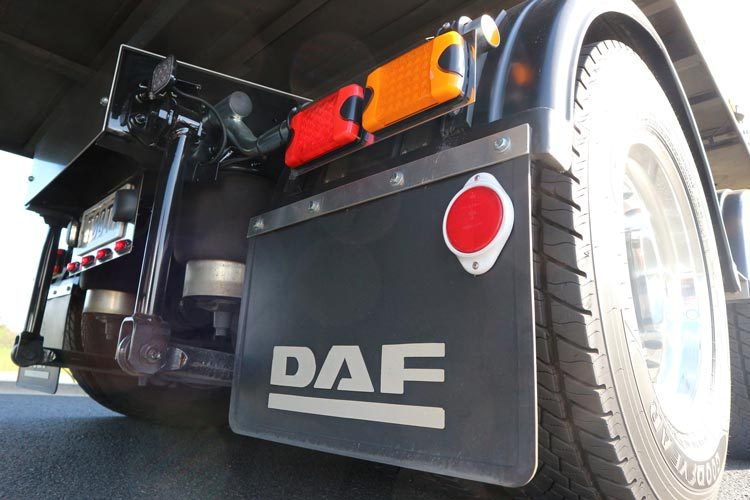 |
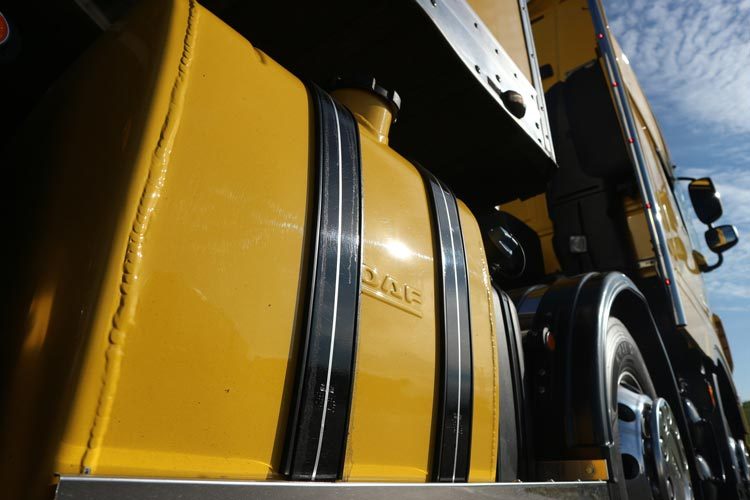 |
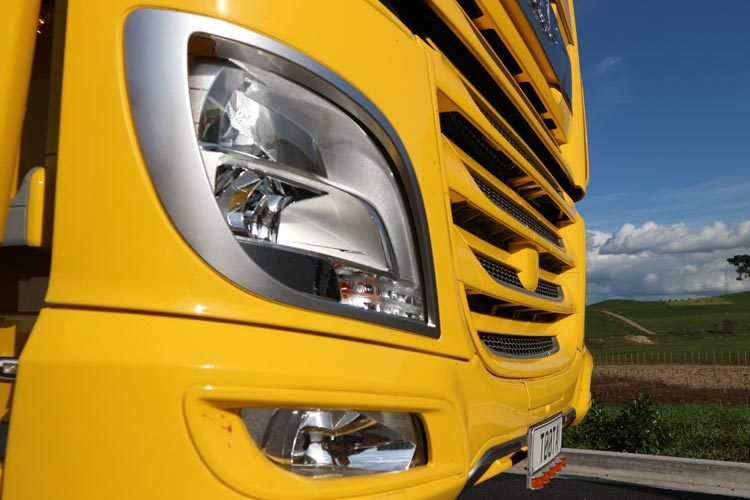 |
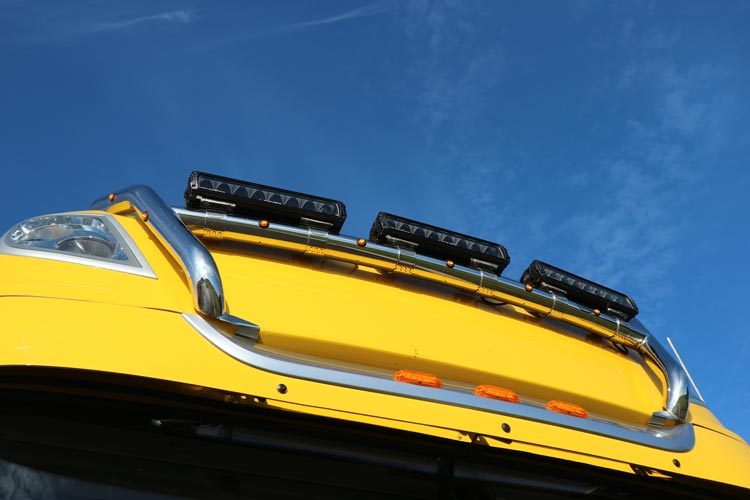 |
If there was ever a state highway with a Jekyll and Hyde persona it‘s SH3. The northern section from Hamilton to New Plymouth has some of the North Island‘s crappiest and patched narrow bits, horrible corners, Mt Messenger, and the other odd nasty pull in amongst it all – definitely Mr Hyde. East from New Plymouth, and it‘s the good Dr Jekyll: flowing, rolling country, corners with more accommodating radiuses, and a surface that‘s better overall than much of the country can boast. East it‘s big Euro, Ecoroll country. So, the question was, had we got into a new truck for the first time on a shit road? If we had, it was doing exceedingly well considering the cab‘s gargantuan size. Our question would be answered later that night, and again in a few days‘ time. Back in the moment, Kaine was all over it though. If you read the sidebar you‘ll see he restores one‘s faith in the ability of talented youth to carry the industry forward. He has an unhurried, considered, and cautious approach to the road. From the ‘never let a chance go by‘ department, the opportunity to jump behind the wheel came. A new-model XF 530 Euro 6 DAF. From the instant I was in place I was back six years to the 105, comfy-as, and happy to deliver the load to Mataura instead of Mokau if needed.
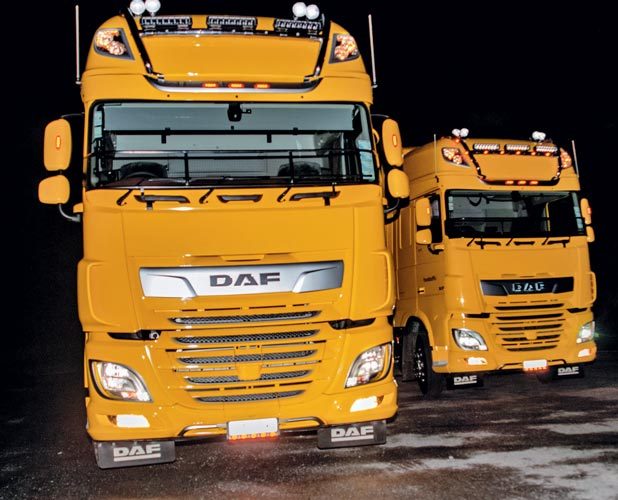 |
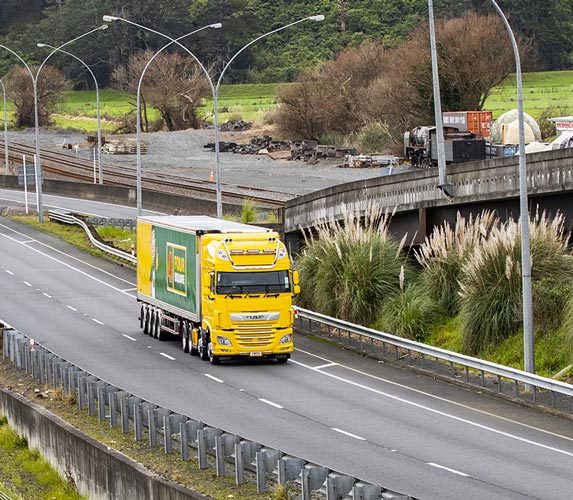 |
It felt new and swanky, yet familiar, the mark of great design. It was effortless keeping the DAF in its lane and the steering was direct; obviously the 8×4 helps there. Visibility was great, and that‘s good news because it‘s been achieved without the need for a huge ‘gorky‘ looking windscreen. Thank goodness for that. The disc brakes were progressive, balanced, and induced confidence, while the TraXon AMT was lightning fast on the changes, and oh my goodness, does this setup like living in the bottom end of the tacho‘s green zone or what? In A-Eco (Auto Economy), the MX-13 engine will drop right back to 1000rpm or fewer before a downshift is contemplated in the cog swapping department. A couple of times the desire for impetus saw me slapping the shifter just to get things going again. In A-Power things stay a little more lively, and of course there‘s ‘M‘ as an option. Dropping off the bottom of the Te Kuiti hill the combined engine and exhaust brake kept the combo well in check.
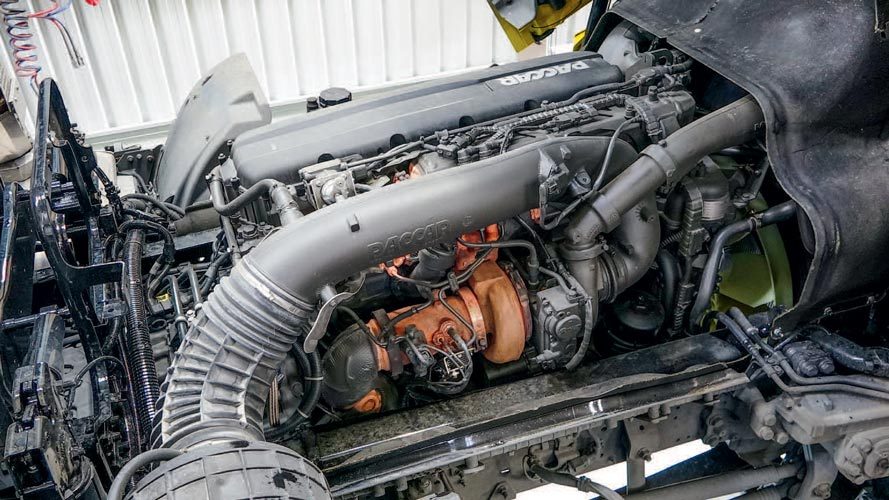 |
 |
| Photos: The MX-13 nestled between the rails. | |
It‘s a three-stage setup delivering 30, 60, and 100% of engine braking, which equates to 1760Nm (1300lb/ft) at 1500rpm and 370kW (495hp) at 2100rpm in the top position. Graham had Southpac‘s Brent Morris, a man described as ‘an absolute DAF guru‘, rewire the engine brake so it worked off the actuators on the clutch and throttle, ‘like a Jacobs‘. The DPA (Driver Performance Assistant) told me I‘d done well, saving brakes, and gave me some ticks, something a person from my era needs to get used to. Obviously your primal reaction is defensive even though the news was good. The thing to get your head around is that the DPA and Seeing Machine bolted to the dash are there to preserve your life, and the truck‘s life. The minute I thought about that, it became an incentive. The other thing is, if you learned to drive a truck prior to 2000, there‘s a lot in your skillsets that are now obsolete, so letting the truck help teach you how get the most out of it is probably handy. Quirky anecdote time. Pedals in 2020 are a far cry from those of generations past. Where once there was a full-length brake pedal and a full-foot throttle plate to allow strategic heel-toe downshifts when needed, now they‘re most commonly pendulums styled from a Toyota Corolla. ‘I‘ve got this‘, say today‘s AMTs. Having said that, we still prefer an organ pedal layout in terms of biomechanical execution, and comfort.
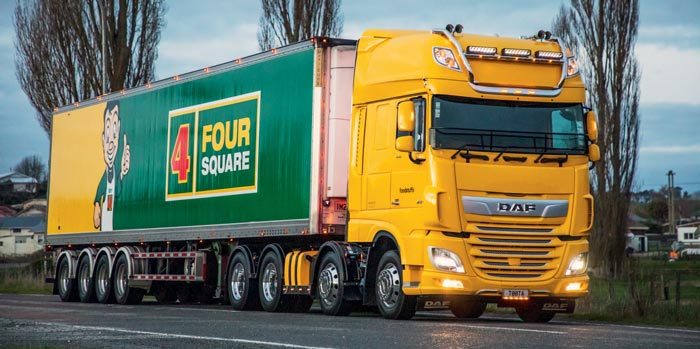
Sensible over sensational
Heading home the truck was sitting at 41 tonne with a load of palletised product. We‘d swapped with Steve Gunning in the other new DAF. It was the swap truck that night. Steve‘s usual ride is a K200 Kenworth, but he was impressed with the DAF‘s comfort and improved performance in the short time since he‘d done a run in it last. Into the pitch black, and the LED lights on the LightFix cab bars overhead illuminated the world to a degree we‘ve never witnessed. To say they turned night into day is completely inadequate really, as few days provide the brightness these do. If you were having a sneaky number two in the bush on the side of the road a kilometre ahead of the approaching DAF … well, it could be embarrassing. The top-lights on the cab proper enhance standard full-beam, the light bars obliterate all other contributions. With the chance for the truck to flex some more muscle we found ourselves back thinking about DAFisms, one being their desire not to get tied up in global power races. The new trucks top out at 390kW (530hp), a modest number in 2020, but here we are, at 41 tonne and still with 9.5kW/tonne (12.7hp). Burning less fuel is where low CO2 resides, and 13 litres displacement at sensible power settings is the perfect compromise between frugality, performance, and longevity. Under the floor is the latest incarnation of PACCAR‘s MX-13 engine, a motor that‘s been a star for them throughout its life and guises. A 12.9-litre common rail unit with a revamped variable geometry turbo that deploys ERG, SCR, and DPF to deliver Euro 6 emissions, and a tail pipe you could probably lick the inside of.
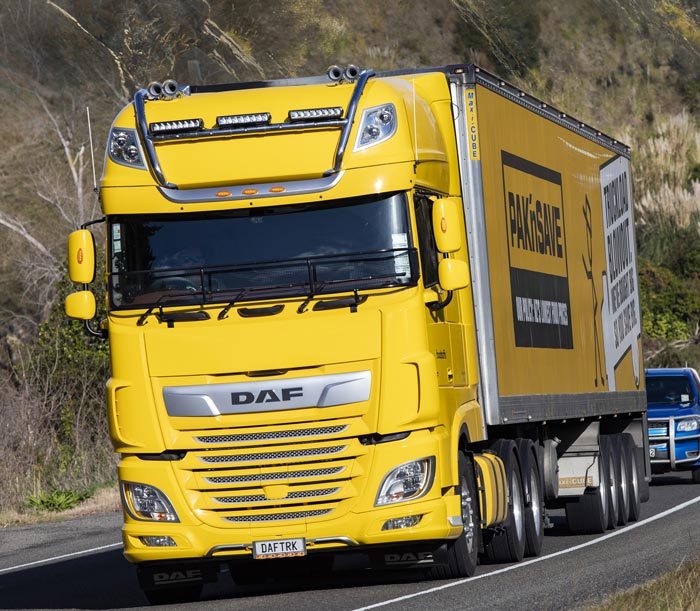
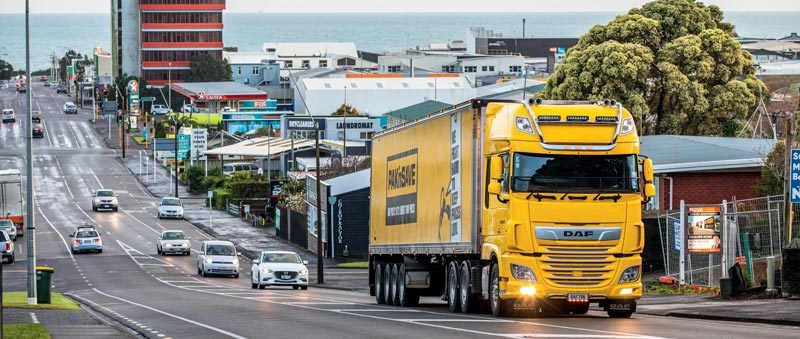
Photo: Blair climbs the hill heading out of New Plymouth. (Below) Cruising past Virginia Lake, Wanganui.
In this latest, slightly less throaty sounding incarnation, there are improved pistons, nozzles, compression ratio, engine parasitics (bits that hang off it like pumps etc.), and an improved exhaust manifold. It‘s a low-revving supremo, with maximum torque of 2600Nm (1920lb/ft) delivered between 1000 and 1460rpm, and peak power of 390kW (530hp) at 1675rpm. At the point torque drops off the chart, power is at about 388kW (520hp). Behind the engine in the 8×4 is the ZF TraXon 16-speed AMT and in the 6×4 it‘s the 12-speed. It‘s a beautifully smooth modular and highly configurable transmission, with lightning shifts attributed in part to a pneumatic clutch actuator (New Zealand Trucking magazine, June 2020, Tech Topics). Kaine powered into the Mahoenui hill, a typical King Country pinch, and the DAF settled in 11th gear, 1500rpm, and 37kph, the place he says it really fights (right on the torque/power crossover). He intervenes in the gear selection department, choosing to shift or kick to keep momentum up. There are no gradual rolling approaches to hills here – it‘s flat, and then you‘re into them. Predictive Cruise Control is probably in the wings and that may be the elixir to intervention. If the truck could know to get a charge on it might hold momentum as it gets into climbing gear. “It loses too much ground, yeah. I just give it a tap and it tends to sit here.”
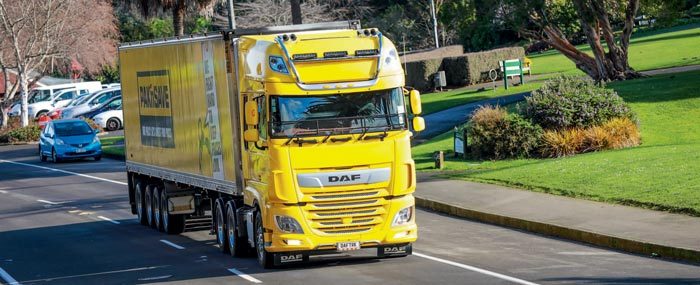
Obviously being a Euro 6 platform truck, don‘t try and spec an XF 530 with a manual. Those crazy, hazy days of swapping your DAF‘s sprockets yourself are gone. Finishing off the spec basics, the front axles in the 8×4 are DAF 163N at 7.1 tonne each on parabolic springs, stabiliser and shocks. At the rear, DAF SR1360T single reduction axles at 3.40:1 with diff and cross lock sit on 8-bag ECAS with stabiliser and shocks again, rated at 18 tonne. In the 6×4 the front axle has an 8.0 tonne rating, and the rear runs 3.40:1 on 21-tonne bags also. Brakes are disc, and the trucks run on 275/70 R22.5 rubber on Alcoa Dura-Bright wheels. Rolling on up back through Otorohanga we turned onto SH39 and aimed the big girl north toward the ‘Tron‘. This road is a better surface for sure, narrow yes, but generally a more consistent surface. This was now the DAF ride we‘d expected, and the cab sat as we remember its predecessor did, with little pitch and roll.
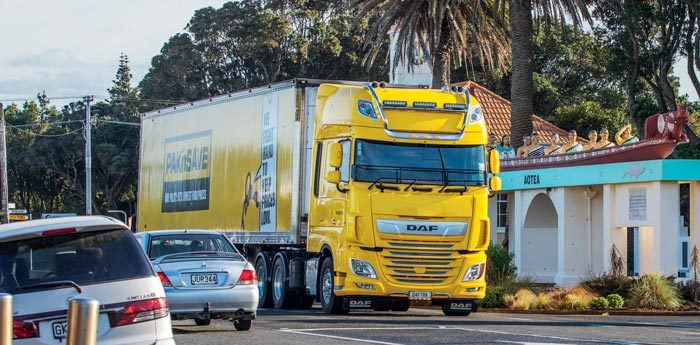
Photo: DAF, right at home. “Poi … taku poi e!”
Sensational and sensible
A few days later we find ourselves with Blair Leslie in the 6×4 truck on his regular run from Palmerston North to New Plymouth and back. Oh, what different world. This is a run where everything the DAF has to give will be more accessible. Like SH39 the carriageway was not antagonistic to the cab‘s desire to lavish us in luxury at a serene 66 to 67 decibels – about as rowdy as we could get either truck – and interestingly, it rode and cornered identical to the 8×4 on similar turf. Aside from emissions, the big step forward for DAF is its arrival on the front lines of safety. The trucks have Adaptive Cruise Control, Forward Collision Warning, Advanced Emergency Braking, Lane Departure, and Vehicle Stability Control. The great news in all this is there‘s no option here either, meaning you can‘t buy one without it all. Why? “We didn‘t want safety to be an option,” said Richard. “If you sell a truck from stock you can‘t retrofit these systems so we took the stance that every Euro 6 DAF would have every safety system available, including air bags, as standard across the range.” Can‘t argue with that. Again, props to Southpac, and they appear to have forced the hand of others. Blair‘s less of an interventionist than Kaine in the gear selection department, although his run lends itself to the AMT world as we said. “I tend to leave it in auto in town and pop it to manual out on the road sometimes, just to reduce the number of gears it‘s changing.” One thing we noticed was the audible tones of skipping gears was greater in the 6×4, obviously just fewer cogs to choose from. In the 16-speed there are gears for Africa and the skips when they occur are harder to detect.
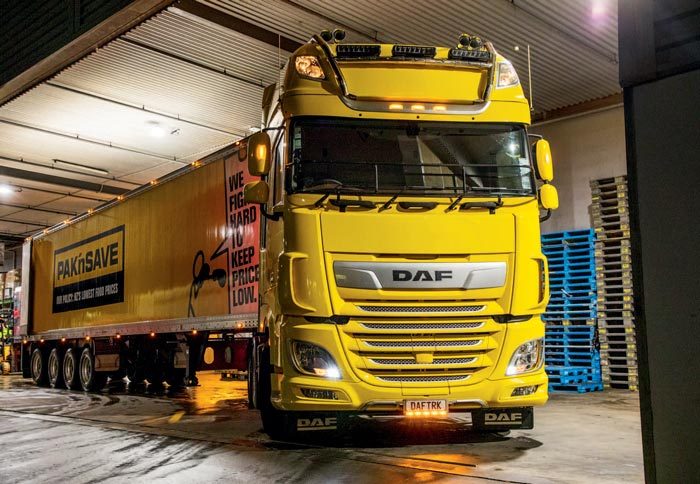
Of the two, Blair‘s truck is doing best on the economy front, at 2.34kpl out of the box only 8000km into a long and happy life, versus the 8×4 sitting at just on 2.0kpl. Three things we‘d say to that. One, the 8×4 is on its second driver already, so has had a couple of different styles no doubt. That was borne out further with Blair in his truck sitting on a 74% DPA score and the 8×4 registering 63%. Two, none of the drivers at the time of writing had received their training; that was booked in and coming soon after. Three, the 6×4‘s run is often lighter, and it spends all its days on Dr Jekyll, not Mr Hyde (east SH3, not north). It‘ll be well worth a check in about 10 months to see how things are going. Blair tows a MaxiCUBE quad reefer also, and having had previous form with a previous employer in the Dutch OEM‘s lower cab offering, he‘s as happy as a sandboy in the new XF ride. “Love it, just love it.” Having unloaded at PAK‘nSAVE New Plymouth, the DAF heads east for home and we turn our attention to the other spectacular aspect of these two machines, presentation. Another two Northchill units showing immense thought and care in how they‘ll look: both trucks with their LightFix bars, LED accessory lighting, colourcoded paint in Foodstuff‘s yellow, towing brand-themed trailers. They‘ve turned heads and lit up the interweb from the moment they were set free to earn a dollar. “The setup on both trucks was done by Aaron Headington‘s team at Southpac who always do an outstanding job,” said Graham. “Likewise, Fleet Image in Te Rapa. The 8×4 came to New Zealand in Jamacan Blue for the roadshow, and was painted into Foodstuffs yellow later. You would swear it‘s factory paint, it‘s that good.” The Redingtons have done the right thing by not attempting to apply Australian- or US-cultured bling to a Euro, but instead, harking back to the DAF‘s origins, presenting two trucks that would hold their own at the annual Truckstar festival in Assen.
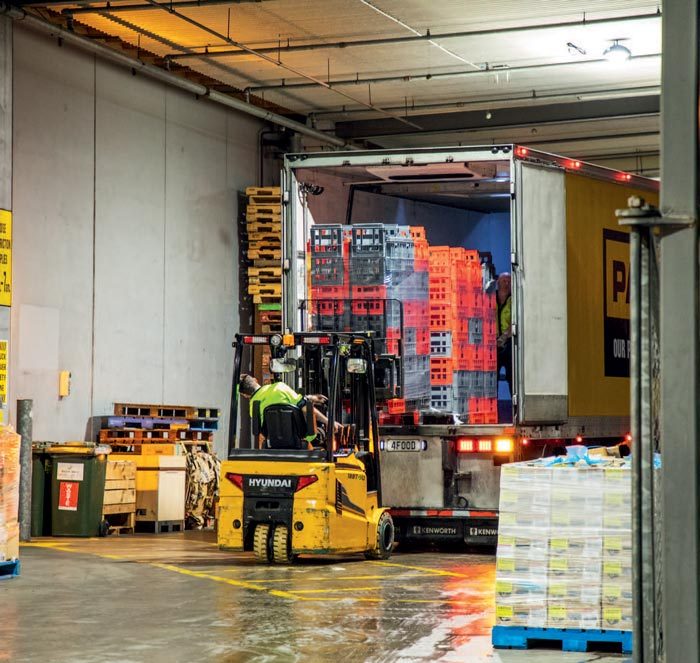
Photo: Unloading in New Plymouth.
“We were particularly excited to work with Graham on these two new Euro 6 units,” said Richard. “They set up exceptionally high spec trucks which really suited the image and presence we wanted for these firsts for the New Zealand market.” Of course the question has to be asked of Graham, ‘Why DAF?‘ “We‘re longtime Southpac customers and I can‘t fault them, for product or support,” said Graham. “They‘re so accessible; even if we want to go and talk with Maarten [Durent, Southpac CEO] he‘s right there and available. I deal with Steve Herring; we‘ve had a long and great relationship with Steve and we‘ve had a great run from challenging and enjoyable. our existing DAFs. These two are perfect for the work they‘re doing.” Blair has a hand in glove look about his driving position already, and you‘d think he was years into driving this truck, not weeks. The three hours home disappears and even outside watching the truck, the appearance of effortless accomplishment is apparent, too easy. Inside it‘s a calm place in a crazy old world. “I‘m looking forward to the training and seeing what I can really get out of it, and know what it can do,” said Blair. The comment from MAN‘s Fredrick Zohm that modern trucks will soon have certified drivers (New Zealand Trucking magazine, June 20) echoed, and the NZTA certificate that comes with this truck‘s training is a clear step in that direction. Blair‘s got 2.34kpl on a 74% DPA score off his own bat. Again, what‘s that going to look like in 10 months?
Summary
These first two DAF XF 530 Euro 6s are DAFs in every way, shape and form. Power and performance in 2020 is largely a given, and at over 7.5kW/tonne (10.0hp) regardless of load, they‘ll go just fine, and you‘ll not find a nicer, more comfortable machine. The reason Europe‘s Big Seven are just that is because each has a DNA that marks them. DAFs are just such likeable, honest trucks. They‘re not pretentious, like the exec who‘s just ‘at home‘ drinking with the boys. But that‘s only part of this story. This is also about cleanliness, efficiency, and safety. Buying trucks nowadays is a long way from securing a mechanical horse for a commercial transport task. Trucks today speak to so much: the values and professionalism of those doing the cartage, of whoever‘s name is on the side, and of those selling the truck. These two trucks speak volumes about every party involved. Like it or not, the time is coming where truck purchasing decisions based on safety systems, or lack of them, is going to be tested in court. When that happens, it‘ll change the face of the industry. Southpac has absolutely done the right thing offering a no-compromise policy on safety tech, and in bringing Euro 6 to market prior to it being mandated. Northchill has done the right thing buying the safest and cleanest trucks it can for its drivers, customers, and wider community, and making them look the way they do demonstrates passion for an industry. And lastly, Foodstuffs, they‘ll benefit from all of the above, the safety of the DAFs, the cleanliness of the emissions, and presentation of the brand. Where they have done the right thing, however, is belief in Kiwis. That local suppliers and operators, passionate family businesses, can deliver world-class results. They are the real stories here.
DIVIDE AND FORTIFY
DAF‘s presence in New Zealand became more than a quirky statistical outlier at the beginning of 1999 when the CF75 and 85 arrived as active models under the Trucks by PACCAR brand revamp, following PACCAR‘s purchase of DAF in 1996. The acquisition meant the famous European could spread its wings to markets in far-off places, like ours. For a while they sat alongside the Foden Alpha in the lineup until Euro 4 signalled the Foden‘s exit. Early on there was no big XF95 either; they didn‘t turn up until 2000. Initially it was all about the rear end and sourcing double drive units that weren‘t ‘severe duty‘ tagged and so too heavy – remember 4×2 reigns in European line haul. But as an article at the time said, PACCAR‘s parts bin fixed that, with Meritor and Kenworth‘s AG suspension sliding right on in. The first proper test in New Zealand Trucking magazine (April 1999) was a CF85 logger brought by Stokes Transport Ltd in Waimauku, (supplied through Continental Heavy Commercials incidentally, not Southpac). The first XF95 test was Mainfreight contractor Ned Kelly in the Hawke‘s Bay in the April 2001 issue. DAF‘s story here has never been one of gradual acceptance. Speaking metaphorically, from the industry coalface at the time they turned up, it was a case of ‘Oh, there‘s a DAF‘ one day, and ‘there are DAFs everywhere‘ the next. The truck‘s popularity is a three-pronged thing from our observation. Firstly, the product offering at the time was bang-on.
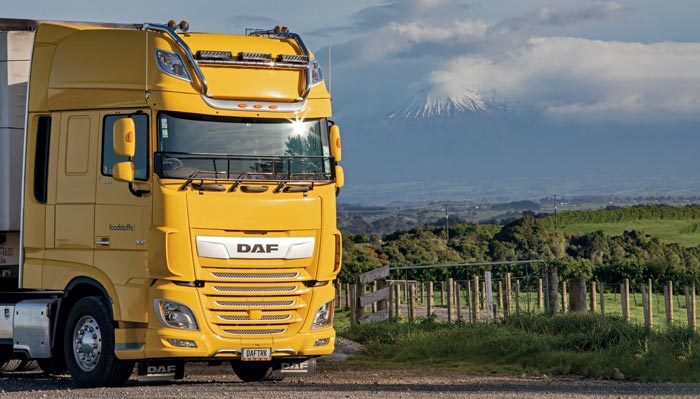
Photo: DAF scaled the market share mountain in New Zealand thanks to local understanding and great support.
Kiwis can take a ‘bit‘ of something new, but being a country of tiny businesses we dry-retch at 100% unknown. When the CF85 turned up it had a 315kW (430hp) 12.6-litre DAF motor, void of electronics – itself still largely a scary new world for everyone – yet able to comply with all this new weird Euro II emissions ‘rubbish‘. It had a ZF transmission, mechanical rear suspension, single trim level, but with everything we loved about Euros, meaning comfy-as. So, power, simplicity, comfort – and it was Euro, and at just over twohundred ‘Gs‘ plus GST for an 8×4, it was pitched right between the Japanese OEMs and much of its European competition. A clear case of ‘why pay that?‘ on one side and ‘Just a few more pingas and you could be in Euro comfort‘ on the other. It was even better for the XF when it turned up because south of the gearbox names like Meritor and KW were clearly visible on some bits, that had also found their way into the CF, as did Eaton Roadranger gearboxes. DAF had pretty much grabbed the market once held by the Fodens, ERFs, and S26 Scammells of the 80s and 90s – ‘the Euro to go, with the bits you know‘. Prong two. Back-up. The key to ensuring the return of any chequebook is support. DAF wasn‘t coming into a whole new world where agencies and dealers needed to be established. Understand you‘re selling a fallible mechanical device, fill the parts bin, and fix them the instant they turn up, that is the key to every dealer success.
And third, growth. Apart from the GFC, DAF arrived as New Zealand was growing; there were expansion sales, not just conquests. Instead of replacing something else, operators could put one alongside something else, and then watch how it went. Looking at post-GFC numbers, many of the OEMs have maintained market share in a growth economy, which in itself equates to greater numbers, but the holy grail in times of growth is increasing market share, and that‘s what DAF did. Based on NZTA NC data (trucks over 12 tonne), DAF has more than doubled its stake, from 3.1% in 2009 to 7.3% in 2019, peaking in 2018 at 8.9%. If you were looking for a casualty of DAF‘s more recent success you‘d have to point to Scania, who lost ground through much of that decade, which may explain some of the recent manoeuvrings in terms of their local structure. In an era where the lineup of trucks in the market is superb, and as we enter uncharted economic waters, it‘s going to be a mouth-watering watch for the next five years at least. Oh … and both original trucks tested, the CF at Stokes and the XF of Ned Kelly‘s, received high honours in the trucks of 10 years past in New Zealand Trucking magazine. In fact, Ned still had the XF at the time.
BIG IS GOOD!
When it comes to cabs, big is definitely good, and DAF‘s Super Space Cab is about where it‘s at in terms of big. You never get sick of entering jumbo cabs; they always invoke a ‘Bloody hell‘ moment, and the near elimination of engine tunnels in big cabovers just exacerbates the impact of the void. These are minimotorhomes. Standing on the 145mm ‘blip‘ in the DAF‘s floor, you‘ve got 2105mm to the roof. The Northchill trucks have a single bunk, and they‘ve come with fridge and microwave. Starting under the bunk from the right is a bottle holder and pull-out caddy, fridge, and storage bin. There‘s under-bunk storage, some of it accessible via external doors. Three big lockers adorn the front overhead, with the microwave in the middle one, and it also has a slot underneath. There are vertical slots along the side walls also. The pull-out table resides in the central console, with swing-out cup holders beneath that and an oddments tray under that again. You might argue in the single bunk cab there‘s potentially more locker space high up – Volvo FH style. Staying with the sleeper, the mattress is 150mm thick pocket-sprung, and there‘s a reading light. Fit and finish is superb; possibly a little too much plastic high in the sleeper but then there‘s a lot of wall to cover and it‘s easy to clean. The cab is finished in ‘Exclusive‘ trim, which is heavy wear plastics and brown vinyl, with silver accents. We think it looks great! The Northchill trucks have the silver fascia against the brown.
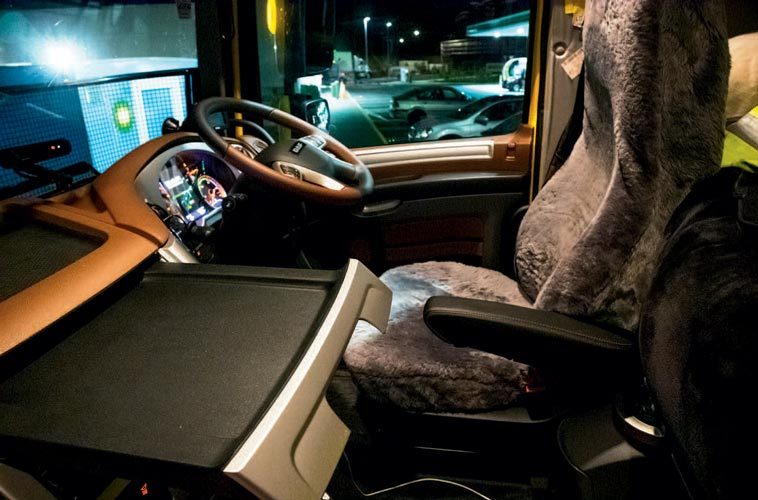 |
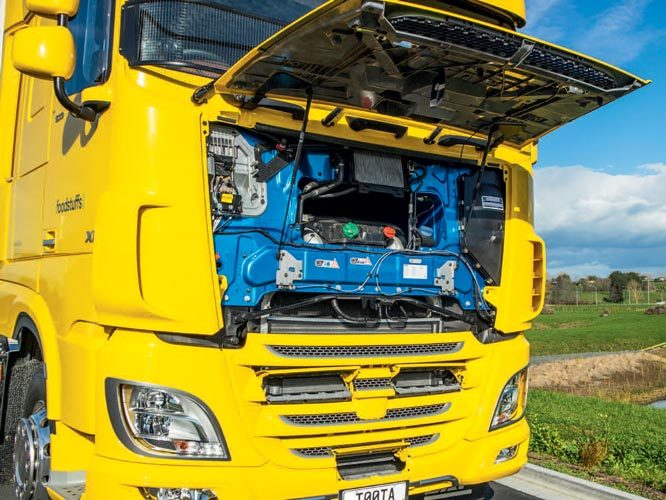 |
| Hercules the wonder table, cup holders are underneath. | Typical Eu
00:00
00:00
Empty Playlist
|





